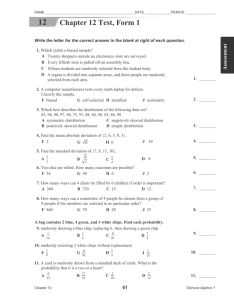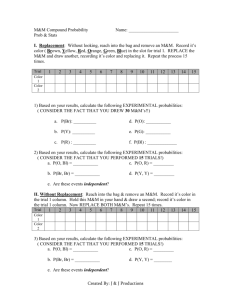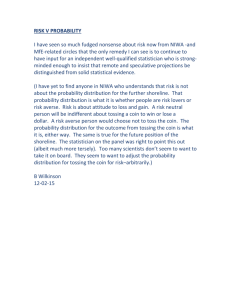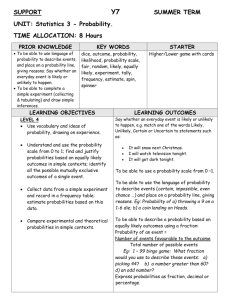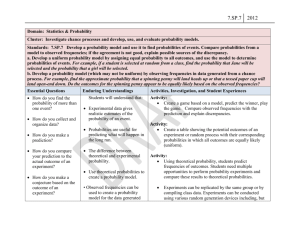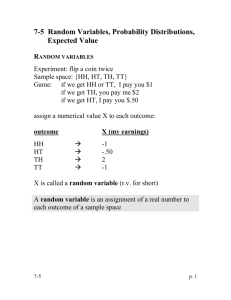File
advertisement
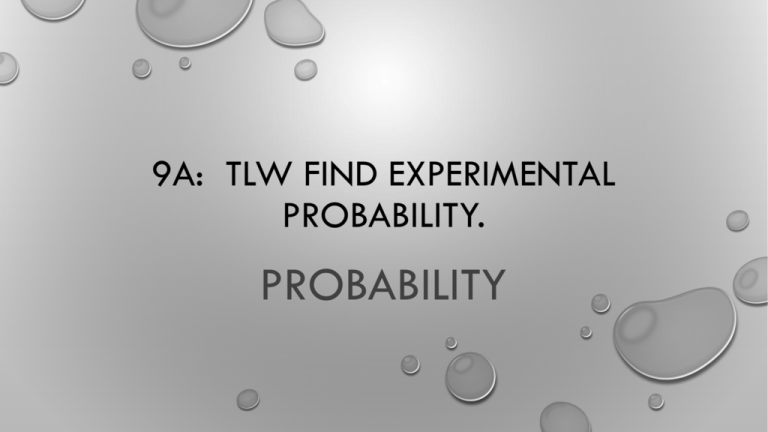
9A: TLW FIND EXPERIMENTAL PROBABILITY. PROBABILITY OPENING PROBLEM • You first roll a die. If the results is less than 3, you randomly select a ball from bag A. Otherwise, you randomly select a ball from bag B. • You win if the ball is red, and lose if the ball is blue. • What is the probability that the die will give a result less than 3? • If bag B is selected, what is the probability that the ball selected will be red? • Are you more likely to win or lose this game? Bag A Bag B PROBABILITY THEORY • Describe the chance or likelihood of an event happening. • We assign every event a value between 0 to 1 inclusive • Impossible: 0% chance of happening • Certain: 100% chance of happening 0 Impossible 0.5 very unlikely to happen not likely to happen equal chance of happening or not 1 likely to happen very likely happen certain HISTORICAL NOTE • IN THE LATE 17TH CENTURY, ENGLISH MATHEMATICIANS COMPILED AND ANALYZED MORTALITY TABLES WHICH SHOWED THAT A PERSON WHO DIED AT DIFFERENT AGES. FROM THESE TABLES THEY COULD ESTIMATE THE PROBABILITY THAT A PERSON WOULD BE ALIVE AT A FUTURE DATE. THIS LED TO THE ESTABLISHMENT OF THE FIRST LIFE-INSURANCE COMPANY IN 1699. EXPERIMENTAL PROBABILITY • NUMBER OF TRIALS: HOW MANY TIMES EXPERIMENT REPEATED • OUTCOMES: ALL POSSIBLE RESULTS FROM AN EXPERIMENT • FREQUENCY: NUMBER OF TIMES AN OUTCOME IS OBSERVED • RELATIVE FREQUENCY: OUTCOME FREQUENCY AS A FRACTION OR PERCENTAGE OF THE TOTAL TRIALS. • EXPERIMENTAL PROBABILITY = RELATIVE FREQUENCY • # 𝑜𝑓 𝑜𝑢𝑡𝑐𝑜𝑚𝑒𝑠 𝑡𝑜𝑡𝑎𝑙 𝑜𝑢𝑡𝑐𝑜𝑚𝑒𝑠 EXAMPLE • WHEN A BATCH OF 145 PAPER CLIPS WAS DROPPED ONTO 6 CM BY 6CM SQUARED PAPER, IT WAS OBSERVED THAT 113 FELL COMPLETELY INSIDE SQUARES AND 32 FINISHED UP ON THE GRID LINES. FIND, TO 2 DECIMAL PLACES, THE EXPERIMENTAL PROBABILITY OF A CLIP OF FALLING: A. INSIDE A SQUARE B. ON A LINE ASSIGNMENT • P.260 #1-4 ESTIMATING PROBABILITIES FROM DATA # 𝑜𝑓 𝑜𝑢𝑡𝑐𝑜𝑚𝑒𝑠 𝑡𝑜𝑡𝑎𝑙 # 𝑜𝑢𝑡𝑐𝑜𝑚𝑒𝑠 EXAMPLE • The table shows the number of short-termed visitors coming to Australia in the period April-June 2011, and the main reason for their visit. a. Find the probability that a person who visited in June was on holiday. b. Find the probability that a person coming to Australia arrived in May. c. Lars arrived in Australia in April, May or June 2011. he came to visit his brother. What is the probability that he arrived in April? Reason for journey April 2011 May 2011 June 2011 Conventions 8300 14800 8800 Business 27200 33900 32000 Visiting 77500 friends/family 52700 59900 Holiday 159300 119300 156500 Employment 4200 4300 5500 Education 9800 7900 12500 Other 35200 28000 33200 Total 321500 260900 308300 ASSIGNMENT • P. 264 #1-3 9B: TLW FIND THE SAMPLE SPACE OF AN EVENT. • Sample Space: the set of all possible outcomes of an experiment • Universal set • Ways of representing the sample set • Lists • Tables • 2-dimensional grids • Venn diagrams • Tree diagrams LISTING OUTCOMES • List the sample space of possible outcomes for • Tossing a coin • Rolling a die 2-DIMENSIONAL GRIDS • Using a 2-dimensional grid, illustrate the possible outcomes when 2 coins are tossed. TREE DIAGRAMS • Illustrate, using a tree diagram, the possible outcomes for: • Tossing two coins • Drawing two marbles from a bag containing, many red, greed and yellow marbles. ASSIGNMENT • P.266 #1-3 9C: TLW FIND THEORETICAL PROBABILITY. 𝑡ℎ𝑒 𝑛𝑢𝑚𝑏𝑒𝑟 𝑜𝑓 𝑚𝑒𝑚𝑏𝑒𝑟𝑠 𝑜𝑓 𝑡ℎ𝑒 𝑒𝑣𝑒𝑛𝑡 𝐴 P(A)= 𝑡ℎ𝑒 𝑡𝑜𝑡𝑎𝑙 𝑛𝑢𝑚𝑏𝑒𝑟 𝑜𝑓 𝑝𝑜𝑠𝑠𝑖𝑏𝑙𝑒 𝑜𝑢𝑡𝑐𝑜𝑚𝑒𝑠 0 ≤ 𝑃(𝐴) ≤ 1 = 𝑛(𝐴) 𝑛(𝑈) EXAMPLE A TICKET IS RANDOMLY SELECTED FROM A BASKET CONTAINING 3 GREEN, 4 YELLOW AND 5 BLUE TICKETS. DETERMINE THE PROBABILITY OF GETTING: A. A GREEN TICKET B. A GREEN OR YELLOW TICKET C. AN ORANGE TICKET D. A GREEN, YELLOW OR BLUE TICKET EXAMPLE • AN ORDINARY 6-SIDED DIE IS ROLLED ONCE. DETERMINE THE CHANCE OF: a. GETTING A 6 B. NOT GETTING A 6 C. GETTING A 1 OR 2: D. NOT GETTING A 1 OR 2 COMPLEMENTARY EVENTS • WHERE ONE EVENT OR THE OTHER MUST OCCUR • GETTING A 6 OR NOT GETTING A 6 • A IS THE EVENT AND A’ IS ITS COMPLEMENT • P(A) + P(A’) = 1 • BEST TO USE WHEN FIND PROBABILITIES THAT INVOLVE “AT LEAST” OR “AT MOST” ASSIGNMENT • P.268 #1-7 USING GRIDS TO FIND PROBABILITIES A VISUAL WAY TO ILLUSTRATE ALL THE OUTCOMES H T H T EXAMPLE • Use a two-dimensional grid to illustrate the sample space for tossing a coin and rolling a die simultaneously. From this grid determine the probability of: • Tossing a head • Getting a tail and a 5 • Getting a tail or a 5 EXAMPLE • There are two square spinners, each with 1, 2, 3, and 4 on their edges. The spinners are twirled simultaneously. Draw a two-dimensional grid of the possible outcomes. Use your grid to determine the probability of getting: • A 3 with each spinner • A 3 and a 1 • An even result with each spinner. DISCUSSION • THREE CHILDREN HAVE BEEN EXPERIMENTING WITH A COIN, TOSSING IT IN THE AIR AND RECORDING THE OUTCOMES. THEY HAVE DONE THIS 10 TIMES AND HAVE RECORDED 10 TAILS. BEFORE THE NEXT TOSS THEY MAKE THE FOLLOWING STATEMENTS: • JACKSON: “IT’S GOT TO BE A HEAD NEXT TIME!” • SALLY: “NO, IT ALWAYS HAS AN EQUAL CHANGE OF BEING A HEAD OR A TAIL. THE COIN CANNOT REMEMBER WHAT THE OUTCOMES HAVE BEEN.” • AMY: “ACTUALLY, I THINK IT WILL PROBABLY BE A TAIL AGAIN, BECAUSE I THINK THE COIN MUST BE BIASED. IT MIGHT BE WEIGHTED SO IT IS MORE LIKELY TO GIVE A TAIL.? • WHO DO YOU THINK IS CORRECT? ASSIGNMENT • P. 270 #1-3 TABLES OF OUTCOMES • SIMILAR TO A GRID, BUT WE ARE SUMMING/SUBTRACTING/MULTIPLYING THE RESULTS • FOR EXAMPLE, WHEN PLAYING A BOARD GAME, YOU ROLL TWO DICE AND MOVE YOUR GAME PIECE THE SUM OF THE ROLLS. EXAMPLE • Draw a tale of outcomes to display the possible results when two dice are rolled and the scores are added together. • Hence, determine the probability that the sum of the dice is 7. ASSIGNMENT • P. 271 #1-3 9D: TLW WILL FIND PROBABILITIES OF COMPOUND EVENTS. • WHAT HAPPENS WHEN I PREFORM TWO SEPARATE EVENTS AND COMBINED THEIR PROBABILITIES? • REMEMBER: AND MEANS MULTIPLY AND OR MEANS ADD. EXAMPLE • Box X contains 2 blue and 2 green balls. Box Y contains1white and 3 red balls. A ball is randomly selected from each of the boxes. Determine the probability of getting “a blue ball from X and a red ball from Y”. Box X Box Y INVESTIGATION 4: PROBABILITIES OF COMPOUND EVENTS • Suppose a coin is tossed and a die is rolled at the same time. The result of the coin toss will be called outcome A and the result of the die roll with be outcome B. P( A and B) P(A) P(B) P(a head and a 4) P(a head and an odd number) P(a tail and a number larger than 1) P(a tail and a number less than 3) • What is the connection between P(A and B), P(A) and P(B)? INDEPENDENT EVENTS • Events that the occurrence of the either of them does not affect the probability that the others occur. • If A and B are independent events then P(A and B) = P(A) x P(B) EXAMPLE • A coin and a die are tossed and rolled simultaneously. Determine the probability of getting a head and a 3 without using a grid. • Assignment: p. 273 #1-6 DEPENDENT EVENTS • Events for which the occurrence of one of the events does affect the occurrence of the other event.y • Example: Suppose a hat contains 5 red and 3 blue tickets. One ticket is randomly chosen, its color is noted, and it is then put aside. A second ticket is then randomly selected. What is the chance that it is red? • Why are these events dependent? • If A and B are dependent events then P(A and B) = P(A) x P(B given that A has occurred) EXAMPLE Drawing items simultaneously implies there is no replacement. • A box contains 4 red and 2 yellow tickets. Two tickets are randomly selected from the box one by one without replacement. Find the probability that: a. Both are red b. The first is red and the second is yellow EXAMPLE • A hat contains tickets with the numbers 1, 2, 3, …, 19, 20 printed on them. If 3 tickets are drawn from the hat, without replacement, determine the probability that they are all prime numbers. ASSIGNMENT • P.274-275 #1-5 TREE DIAGRAMS • Illustrate sample spaces if the alternatives are not too numerous. • Consider two archers firing simultaneously at a target. Li has a probability ¾ of hitting a target 4 5 and Yuka has a probability . Draw a tree diagram representing the results. • The probabilities for hit or miss is on the diagram • There are four branches for all the possible outcomes • Multiply along the branch to find the probabilities. EXAMPLE • Carl is not having much luck lately. His car will only start 80% of the time and his motorbike will only start 60% of the time. • Draw a tree diagram to illustrate this situation • Use the tree diagram to determine the chance that: • Both will start Carl can only use his car. EXAMPLE • Two boxes each contain 6 petunia plants that are not yet flowering. Box A contains 2 plants that will have purple flowers and 4 plants that will have white flowers. Box B contains 5 plants that will have purple flowers and 1 plant that will have white flowers. A box is selected by tossing a coin, and only plant is removed at random from it. Determine the probability that it will have purple flowers. ASSIGNMENT • P. 277-278 #1-8 9F: TLW FIND PROBABILITY OF SAMPLING WITH AND WITHOUT REPLACEMENT • Sampling with replacement: object put back in the group before an object is chosen again. • Sampling without replacement: object is put to one side and then another object is chosen. • Consider a box containing 3 red, 2 blue and 1 yellow marble. Let’s examine the probabilities with replacement and without replacement. EXAMPLE • A box contains 3 red, 2 blue and 1 yellow marble. Find the probability of getting two different colors: • If replacement occurs • If replacement does not occur. EXAMPLE • A bag contains 5 red and 3 blue marbles. Two marbles are drawn simultaneously from the bag. Determine the probability that at least one is red. ASSIGNMENT • P.279-280 #1-8 9G: TLW CALCULATE THE EXPECTED VALUE. • Expectation: if we preform n trials of an experiment and each event has a p probability, then we expect the numbers of times for the event to occur is np. • Example: if we roll a six sided die 12 times, we expect to roll a 5 twice. • Example: Each time a footballer kicks for goal he has a ¾ chance of being successful.. In a particular game he has 12 kicks for goal. How many goals would you expect him to score? • Assignment: p. 282 #1-6 EXPECTED VALUE • When the spinner is spun, players are awarded the resulting number of points. On average, how many points can we expect to be awarded per spin? • It is impossible to score 20 points on a given spin, but over many spins we expect an average of 20 points per spin. 5 10 50 15 EXPECTED VALUE=𝑥1 𝑝1 + 𝑥2 𝑝2 + ⋯ + 𝑥𝑛 𝑝𝑛 = 𝑥𝑖 𝑝𝑖 • EXAMPLE: A magazine store recorded the number of magazines purchased by its customers in one week. 23% purchased on magazine, 38% purchased two, 21% purchased three, 13% purchased four, and 5% purchased five. • Find the average numbers of magazines purchased by customers over a long period. ASSIGNMENT • P.283 #1-5 FAIR GAME • When the expected return/payout from the game minus the cost to play is zero. • Example: In a game of chance, a player spins a square spinner labelled 1, 2, 3, 4. The player wins the amount of money shown in the table, depending which number comes up. • Determine: • The expected return for one spin of the spinner • The expected gain for the player if it costs $5 to play each game. • Whether the game is fair. Number 1 2 3 4 Winnings $1 $2 $5 $8 ASSIGNMENT • P.284-285 #1-6 9H: TLW USE VENN DIAGRAMS TO DETERMINE PROBABILITIES. • Venn diagrams help by representing all the events in a sample space. • Example: Rolling a six sided die and getting a number less than three. U 6 4 3 5 1 A 2 EXAMPLE • The Venn diagram alongside represents the set U of all children in a class. Each dot represents a student. The event E shows all those students with blue eyes. Determine the probability that a randomly selected child: • Has blue • Does not have blue eyes **** **** **** *** E’ **** **** E EXAMPLE • In a class of 30 students, 19 study Physics, 17 study Chemistry, and 15 study both of these subjects. Display this information on a Venn diagram and hence determine the probability that a randomly selected class member studies: • Both subjects • At least one of the subjects • Physics but not Chemistry • Exactly one of the subjects • Neither subject ASSIGNMENT • P.287-288 #1-10 9I: TLW APPLY THE LAWS OF PROBABILITY. • In the chapter on Venn diagrams we learned: 𝐴 ∪ 𝐵 = 𝐴 + 𝐵 − 𝐴 ∩ 𝐵 . This is also true for probability. • 𝑃 𝐴 ∪ 𝐵 = 𝑃 𝐴 + 𝑃 𝐵 − 𝑃(𝐴 ∩ 𝐵) • This is very important. It will be used often. EXAMPLE • IF P(A) = 0.6, 𝑃 𝐴 ∪ 𝐵 = 0.7, AND 𝑃 𝐴 ∩ 𝐵 = 0.3, FIND P(B). MUTUALLY EXCLUSIVE OR DISJOINT EVENTS • MUTALLY EXCLUSIVE: 𝑃 𝐴 ∩ 𝐵 = 0 • 𝑃 𝐴∪𝐵 =𝑃 𝐴 +𝑃 𝐵 EXAMPLE • Of the 31 people on a bus tour, 7 were born in Scotland (S), and 5 were born in Wales (W). • Are S and W mutually exclusive events? • If a member of the tour is chosen at random, find the probability that he or she was born in: I. Scotland II. Wales III. Scotland or Wales ASSIGNMENT • P. 290 #1-5 9J: TLW APPLY CONDITIONAL PROBABILITY • If we have two events A and B, then • 𝐴 𝐵 is used to represent the “A occurs knowing that B has occurred”. • 𝐴 𝐵 is read as “A given B”. • We are told something has happened and we find the probability that something happens afterward. • 𝑃 𝐴𝐵 = 𝑃(𝐴∩𝐵) 𝑃(𝐵) EXAMPLE • In a class of 25 students, 14 like pizza and 16 like iced coffee. One student likes neither and 6 students like both. One student is randomly selected from the class. What is the probability that the student: • Likes pizza • Likes pizza given that he or she likes iced coffee EXAMPLE • In a class of 40 students, 34 like bananas, 22 like pineapple, and 2 dislike both fruits. A student is randomly selected. Find the probability that the student: • Likes both fruit • Likes at least one fruit. • Likes bananas given that he or she likes pineapple • Dislikes pineapple give that he or she likes bananas. EXAMPLE • The top shelf in a cupboard contains 3 cans of pumpkin soup and 2 cans of chicken soup. The bottom shelf contains 4 cans of pumpkin soup and 1 can of chicken soup. • Lukas is twice as likely to take a can from the bottom shelf as he is from the top shelf. Suppose Lukas takes one can of soup without looking at the label. Determine the probability that it: • Is chicken • Was taken from the top shelf given that it is chicken ASSIGNMENT • P.291 #1-12 9K: TLW FIND THE PROBABILITY OF INDEPENDENT EVENTS • A and B are independent events if the occurrence of each one of them does not affect the probability that the other occurs • 𝑃 𝐴 ∩ 𝐵 = 𝑃 𝐴 𝐵 = 𝑃 𝐴 𝐵′ = 𝑃 𝐴 𝑃(𝐵) EXAMPLE 1 2 1 3 • Suppose 𝑃 𝐴 = AND P(B) = . FIND 𝑃(𝐴 ∪ 𝐵) IF: • A AND B ARE MUTUALLY EXCLUSIVE • A AND B ARE INDEPENDENT EXAMPLE 2 5 • Suppose P(A) = , 𝑃 𝐵 𝐴 = 1 , 3 1 4 and 𝑃 𝐵 𝐴 = , find P(B) and 𝑃(𝐴 ∩ 𝐵′ ) ASSIGNMENT • P. 294 #1-6
